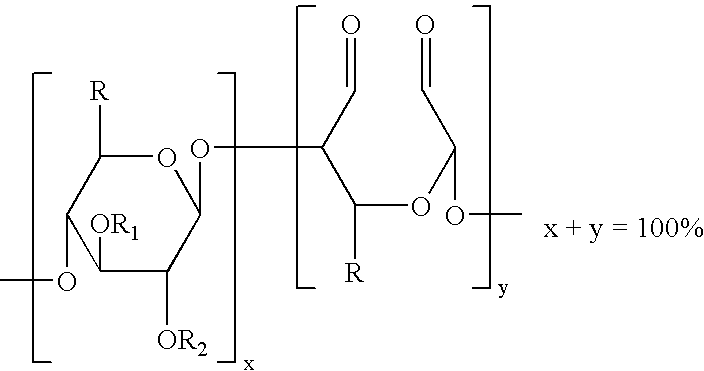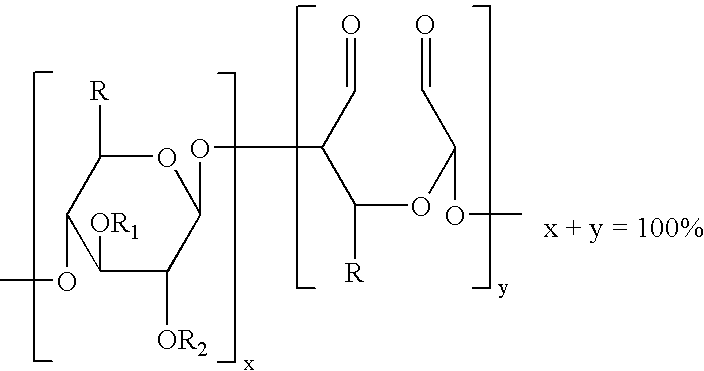Method of providing hemostasis to a wound
- Summary
- Abstract
- Description
- Claims
- Application Information
AI Technical Summary
Problems solved by technology
Method used
Image
Examples
example 1
Preparation of Knitted Aldehyde-Modified Regenerated Cellulose fabric:
[0052] A 15.75 g piece of Nu-Knit® rayon fabric was cut in the form of a strip 1.5 inches wide. The strip was wound on a mandrel and suspended in 600 ml of aqueous isopropyl alcohol (IPA) (200 ml IPA / 400 ml de-ionized (DI) water). 20.8 g of sodium periodate (Aldrich, Milwaukee, 53201) was dissolved in the solution (1:1 molar ratio) and the mandrel was rotated at moderate rpm in the solution for 21 hours at ambient temperature. It is essential that the oxidation of the fabric be conducted in the dark. The solution pH was 3.8. The solution was discarded after the reaction. The mandrel with the oxidized fabric was washed for 30 minutes in 1 liter of cold DI water containing 50 ml of ethylene glycol. It was then washed with aqueous IPA (50 / 50) for 15 minutes, followed by a pure IPA wash for 15 minutes. The fabric was dried in ambient air for several hours. [Aldehyde content: Ave. 22.83%]
[0053] The oxidized fabric th...
example 2
Preparation of Non-Woven Aldehyde-Modified Cellulose Fabric:
[0054] A 10 g piece of cellulose rayon non-woven fabric was cut in the form of a rectangle and placed in an aqueous solution of sodium periodate (Aldrich, Milwaukee, 53201) (1:0.7 molar ratio). The fabric was placed in a container modified to exclude light and soaked in the dark for 24 hours at 37° C. The solution was discarded after the reaction. The fabric was repeatedly washed with DI water until the pH was 6-7. It was then washed with aqueous IPA (50 / 50) for 15 minutes. The fabric then was washed in pure IPA for 15 minutes. The fabric was dried in ambient air for several hours. [aldehyde content: 51.04%]
[0055] The oxidized fabric then was evaluated for hemostasis as set forth below. Results are provided in Table 1.
example 3
Preparation of Aldehyde-Modified Regenerated Cellulose Powders:
[0056] 10.6 g of powdered cellulose rayon was suspended in an aqueous solution of sodium periodate (Aldrich, Milwaukee, 53201)(13.9 g in 250 ml DI water] and stirred for 7 hours at ambient temperature in the dark. The solution was filtered after the reaction. The filtrate was repeatedly washed with DI water until the pH was in the range of from 6 to 7. It was then washed with aqueous IPA (50 / 50) and pure IPA for 15 min each. The powder was dried in air for several hours. [aldehyde content: 32.8%]
[0057] The oxidized powder then was evaluated for hemostasis as set forth below. Results are provided in Table 1.
PUM
| Property | Measurement | Unit |
|---|---|---|
| Fraction | aaaaa | aaaaa |
| Fraction | aaaaa | aaaaa |
| Fraction | aaaaa | aaaaa |
Abstract
Description
Claims
Application Information
 Login to View More
Login to View More - R&D
- Intellectual Property
- Life Sciences
- Materials
- Tech Scout
- Unparalleled Data Quality
- Higher Quality Content
- 60% Fewer Hallucinations
Browse by: Latest US Patents, China's latest patents, Technical Efficacy Thesaurus, Application Domain, Technology Topic, Popular Technical Reports.
© 2025 PatSnap. All rights reserved.Legal|Privacy policy|Modern Slavery Act Transparency Statement|Sitemap|About US| Contact US: help@patsnap.com



